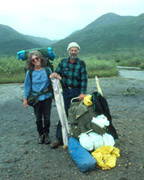Night Photography in Death Valley National Park
©Bert Gildart: Surely anyone over age 55 can remember seeing the old teams of 20 mules pulling their load of “20-Mule Team Borax” in the highly dramatized TV series Death Valley Days hosted by Ronald Reagan. In real life, the mules were pulling their loads from Harmony Works, located about two miles from where we’re now docked at Sunset Campground. From Harmony, the teams pulled loads 165 miles to the train depot in Mojave. The television series was shown in the 1950’s and 1960’s and romanticized the mineral, the period of time and the people who worked the claims, trying as they did to extract “white gold.”
Borax made some lucky people millionaires almost overnight. In the peak years of the late 1800s, several mines existed in the area. Ultimately, by the end of the borax era in the late 1920’s, some $30,000,000 of the “white gold” had been taken from the Death Valley area, although some borax was taken out until the 1970s. As well known as it is, Harmony Borax Works was only active for five years, from 1883 to 1888.
PHOTOGRAPHER’S CHALLENGE
Today, not much exists but an old wagon, and if you are a photographer, your challenge is to evoke that nostalgic period, and my thought was to backdrop it against a night full of stars. That idea wouldn’t work just anywhere, but in Death Valley it does, as this largest of all parks outside of those in Alaska is one of the few remaining places in the country — perhaps the world — where light pollution remains almost non existent. To make this picture work, you must first have those conditions, but there’s still a challenge, and that is one of photographic technique. (Also see northern lights photography and digital night photography–Organ Pipe.)
Before leaving our Airstream, I made several test exposures of the night sky using different ISOs, different f stops and different lengths of time. Using that test information, ultimately, this image was taken with a very high ISO of 3600, but I also found that an ISO of 600 provided an excellent rendition of the myriad of stars as individual points of light.
EXPOSURE DATA
By their very nature, wide angle lenses provide incredible depth of field, so that was my lens of choice, in this case a 12mm one. Obviously, I wanted the wagon in focus as well as the night sky.
Other exposure data is as follows: I opened the aperture to f4 and by setting my Nikon D300 to “B” was then able to hold open the shutter for about one full minute, using a cable release. As well, I programmed the camera from “Menu” to include “high noise reduction.” I used two Nikon SB800 strobes setting the on-camera strobe to Commander Mode, the other to the Remote Mode. I programmed the on-camera strobe to underexpose the front of the wagon one full f-stop. We’re camped adjacent to Don and Nancy Dennis (also Airstream enthusiasts), and Don joined me and volunteered to hold the auxiliary strobe. He held it high and positioned himself about half way along the length of the wagon train.
Night descends early in Death Valley at this time of year, so this was not a late night photo; instead, it was made around 7:30 pm. Prior to my evening excursion, I visited the area and evaluated the wagon for composition, something performed much more easily by light of day. At the time, I didn’t realize the Milky Way would be in just the right position or that a shooting star would streak across the night sky, adding just the right touch of the surreal.
Death Valley can challenge photographers in many ways, but for me, this photo of the old wagon backdropped by the night sky will probably be the most rewarding image of this particular trip.
_________________________________________________
THIS TIME LAST YEAR
ADS FROM GOOGLE AND AMAZON AUGMENT OUR TRAVELS



February 6th, 2010 at 11:21 am
Just have to react a bit.. One of the last places – perhaps the world – where light pollution remains almost non existent.. Hrrmm, you have not been around much, have you? We could start with the sahara desert that is almost as big as USA. There are also some other really large deserts around the world. Then we have the part of russia called siberia, that region alone is larger than the USA and has only 36 million people living there. Take also a close look at Greenland, the worlds largest island, it is the least densely populated country in the world with 0.069 people per square mile. Then you have the poles too, especially the southern one is really large. In Mongolia you will also find very large totally unpopulated areas bigger than many countries. Of course you can also take a closer look at Canada that also have very large unpopulated areas, the same to the south in Brazil. So, where does this end? Actually, most of the landmass in the world is actually quite unpolluted of man made lights, not the other way around.
Beautiful shot of the wagon though.
May 3rd, 2012 at 10:58 pm
some of these shots are so amazing